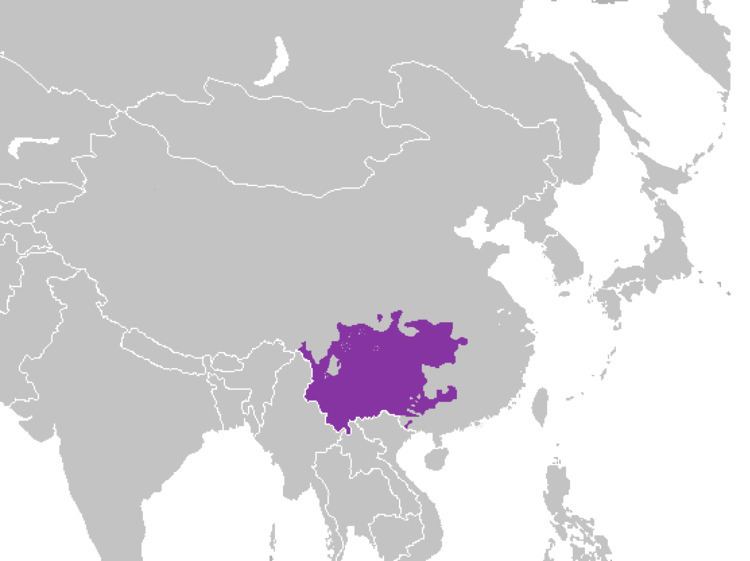ISO 639-6 xghu Linguasphere 79-AAA-bh | Glottolog xina1239 | |
 | ||
Region Sichuan, Yunnan, Guangxi, Guizhou, Hubei, Lao Cai in Northern Vietnam, Laos, Kokang in Northern Myanmar, Wa State, Chiang Mai in Thailand Native speakers more than 260 million (date missing) Language family Sino-TibetanChineseMandarinSouthwestern Mandarin | ||
Southwestern Mandarin (simplified Chinese: 西南官话; traditional Chinese: 西南官話; pinyin: Xīnán Guānhuà), also known as Upper Yangtze Mandarin (simplified Chinese: 上江官话; traditional Chinese: 上江官話; pinyin: Shàngjiāng Guānhuà), is a primary branch of Mandarin Chinese spoken in much of central and southwestern China, including in Sichuan, Yunnan, Chongqing, Guizhou, most parts of Hubei, the northwestern part of Hunan, the northern part of Guangxi, and some southern parts of Shaanxi and Gansu. Some forms of Southwest Mandarin are not entirely mutually intelligible with Standard Mandarin Chinese or other forms of Mandarin.
Contents
Varieties of Southwestern Mandarin are spoken by roughly 200 million people. If removed from the larger "Mandarin Chinese group", it would have the 8th-most native speakers in the world, behind Mandarin itself, Spanish, English, Hindi, Portuguese, Arabic and Bengali.
Overview
Modern Southwestern Mandarin was formed by the waves of immigrants brought to the regions during the Ming and Qing Dynasties. Because of this comparatively recent move, these dialects show more similarity to modern Standard Mandarin than to other varieties of Chinese like Cantonese or Hokkien. For example, like most southern Chinese dialects, Southwestern Mandarin does not possess the retroflex consonants (zh, ch, sh, r) of Standard Mandarin, but nor does it retain the entering tone, as most southern dialects do. The Chengdu-Chongqing and Hubei dialects are believed to reflect aspects of the Mandarin lingua franca spoken during the Ming Dynasty. However, some scholars believe its origins may be more similar to Lower Yangtze Mandarin. Though part of the Mandarin group, Southwestern Mandarin has many striking and pronounced differences with Standard Mandarin such that, until 1955, it was generally categorized alongside Cantonese and Wu Chinese as a branch of Chinese varieties.
Southwestern Mandarin is the common language in the (Kokang people Han-Chinese majority) Kokang district in Northern Myanmar. Southwestern Mandarin is also one of two official languages of the Wa State, an unrecognised autonomous state within Myanmar, alongside Wa language. Because Wa has no written form, Chinese is the official working language of the Wa State government. Some of its speakers live in Thailand. (Chin Haw) It is also spoken in parts of Northern Vietnam. Ethnic minorities in Vietnam's Lao Cai Province used to speak Southwestern Mandarin to each other when their languages were not mutually intelligible. Southwestern Mandarin is also used between different ethnic minorities in Yunnan. As it is in Guangxi.
Tones
Most Southwestern Mandarin dialects have, like Standard Mandarin, only retained four of the original eight tones of Middle Chinese. However, the entering tone has completely merged with the light-level tone in most Southwestern dialects, while in Standard Mandarin it is seemingly randomly dispersed among the remaining tones.
Syllables
Southwestern Mandarin dialects do not possess the retroflex consonants of Standard Mandarin, but otherwise share most Mandarin phonological features. Most have lost the distinction between the nasal consonant /n/ and the lateral consonant /l/ and the nasal finals /-n/ and /-ŋ/. For example, the sounds "la" and "na" are generally indistinguishable, as well as the sounds "fen" and "feng". Some varieties also lack a distinction between the labiodental sound /f/ and the glottal /h/.
Subdivisions
Southwestern Mandarin was classified into twelve dialect groups in the Language Atlas of China:
